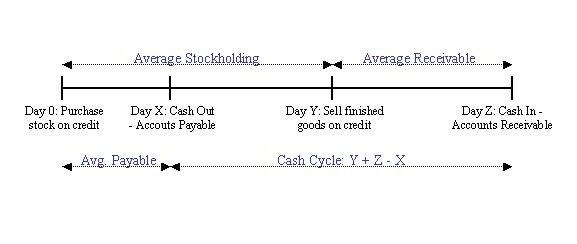Working Capital:
The Best Performers Focus on Two Metrics
The best way to relieve working capital pressure is to lower inventory and improve the cash-to-cash cycle. Of all of the different ways to measure working capital performance, there are two that stand out: cash-to-cash days and the percent return on working capital. Both measures are easy to calculate and are superior benchmarks, unaffected by company size or market. Both are easy to calculate from the balance sheet and income statement for any financial period.
Cash-to-cash is also called the cash conversion cycle. The formula for calculating cash-to-cash is:

Return on working capital is a simple formula from the financial statements:
Operating Income / Current Assets (Current assets include accounts receivable, accounts payable and inventory.)
Working capital management is a short-term focus on ensuring that there is sufficient cash to maintain ongoing operations. When a company screws up its working capital management, it can run out of the cash needed to sustain operations, causing the company to asphyxiate and die.
There are four key levers in working capital management: cash management, inventory management, debtors management, and short-term financing. With four levers there comes a question: Which is the most important?
Our research into inventory and cash creation illustrates that most distributor and retail companies gain the most powerful leverage with inventory management. Our analysis of distributors and retailer financial performance using our suite of analysis tools shows that a reduction of a single day of on-hand inventory doubled or tripled cash compared to a one-day reduction of receivables or a one-day increase of payables.
The latest Aberdeen report on working capital (Working Capital Optimization – May 2010) backs our analysis. The Aberdeen benchmarking shows a dramatic difference between best-in-class and average companies, and obviously an even greater spread between the best-in-class and the laggards. Best-in-class companies perform at a cash-to-cash ratio of 21 days, which is 2.8 times the average and almost 3 1/2 times the performance of the laggards. In light of our analysis and the impact on cash generation, this spread on the percent of return on working capital is no surprise. Best-in-class companies create a 43% return on working capital, twice the rate of average companies, and almost five times the performance level of the laggards.


